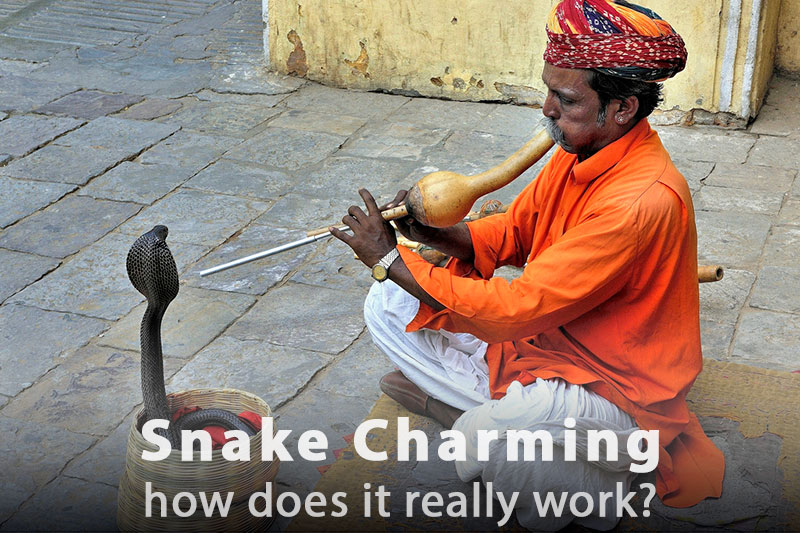Thanks to numerous films, cartoons, and fairy tales, it is widely believed today that there are such people somewhere on Earth who can make a snake dance. This dangerous reptile is thought to bow to its owner, be sensitive to the flute sounds, and almost never try to attack. Is it a miracle of human supremacy over nature, or is it a trick, very cruel and sneaky? This is something worth to be dealt with in precise detail.

No, it doesn't. It actually can't hear the flute tune or other high-frequency sounds.
It is actually dodging or getting in a more advantageous position since the snake takes the flute as a threat.
Well, it's not. Snake charmers are sometimes very inventive and brutal in trying to protect themselves from snakes.
Although India is the birthplace of this "art,” it has also become popular in Egypt, Pakistan, and many countries of Southeast Asia. This entertainment is now being prohibited, though.
It varies across places, including cobras, vipers, pythons, and other reptiles.
Let's first dig into some nuances. The musical instrument used to make snakes "dance" is neither a flute nor a pipe but a pungi. Traditionally, it is made of dried pumpkins. The pungi often has a special tube attachment to make it longer. We'll talk about its purpose later below.
The snake is just not able to dance to a flute or even to a real pungi because it is almost totally deaf. It lacks the middle and outer ears as well as the eardrums. Snakes can feel soil vibrations instead and thus track small and large animals nearby.
So how do snakes dance to the tune if they don't hear the sound? In fact, it's not dancing that snakes are doing but dodging. They take the instrument as a danger. That's it! And charmers do their best to fuel the snake's fear. Since the first day a snake is caught, it is repeatedly hit on the head with the flute—without overdoing and causing serious injuries or sending it to glory but hard enough to develop the snake's ill feeling about a foreign, long object and the desire to distance from it.
With this in mind, dance motions are now clear. The snake charmer is playing the pungi (only for tourists, not for the reptile) the way to make the snake move left and right. Keeping in mind the danger of being hit, a poor snake carefully watches the pungi. Every time it changes position, the snake dodges in the opposite direction to be as far from the instrument as possible. This might as well be a simple stick: beat a snake's head with a stick once in a while for weeks, then use its emerging fear, and you'll see exactly the same response. And, of course, all the magic about charming is going right away.
Charmers can use a variety of snakes, including vipers, cobras, pythons, or others. And in most cases, they use those inhabiting their area of living to simplify catching. But, of course, the most impressive "dancers" are poisonous snakes whose single bite can kill a person — tourists literally squeal at every reptile's sharp move.
But charming actually is of a tiny or even no danger. There is a whole set of various techniques to charm a snake safely—from relatively humane to extremely cruel ones, like the very same tube attached to the pungi.
The tube doesn't have any other purpose than extending a musical instrument. It allows charmers to sit themselves as far from the snake as possible, meaning a lower risk of getting bitten.
There are even more brutal measures, like putting a snake into a box or package for days. During all this time, a poor reptile cannot eat, drink, or move. Its muscle tone is suffering, making the snake soft and lifeless. It is no longer capable of making a sharp jump. So gullible tourists firmly believe it is the trance a snake is experiencing under the magical melody's impact, not its strengthlessness.
This is not the limit of cruelty for the sake of protecting one's life. Some remove snakes’ venom glands and fangs or even sew up their mouths, leaving only a tiny hole. This hole is enough for an unfortunate snake to stick out its tongue (the show would not be that spectacular without it) but too small to bite a tamer. However, snakes that have undergone this surgery do not live long—it’s mostly only a few weeks following the death from oral infections and hunger. But tamers do not care too much—there are always special merchants selling new victims to "train", and it won’t take more than a month and a half. Fortunately, this entertainment is getting now intensively banned.
Although the first written sources to mention snake charmers and their wards were found in Ancient Egypt, India is generally recognized as the real snake-taming homeland. It was Indian people who started considering snakes sacred animals and often had them accompanying gods of the local pantheon. Such virtuosity expectedly attracted many viewers ready to pay handsomely for an incredible spectacle. Then the art has spilled over to other countries: Egypt, Pakistan, Tunisia, Morocco, Malaysia, Thailand, and more.
Today, the charming ritual is not that widespread. It's all about the Wild Life (Protection) Act that was adopted in 1972 in India. It was originally aimed at grappling with the snakeskin product sale. But in 1990, the Act was amended to include more crimes that can lead to long prison terms. Hence, today Indian snake charmers can end up behind bars for 7 years if their crime is proven. Therefore, you won't see this show in metropolises. Some charmers can still be found operating in some small villages, but it's a rare thing that takes place only at fairs or other crowded places. On the one hand, the Act angered many tamers: the art of charming was passed from father to son and resulted in thousands of people being put out of business. On the other hand, it helped to save the lives of a huge number of snakes, who otherwise would have had a sad fate.
So next time you visit India and come across a dancing snake in some remote village, remember it's not dancing but trying to escape stick drubbing and is likely to die soon. And there is no good in supporting such animal treatment by giving money to the charmer.
References: Links and sources